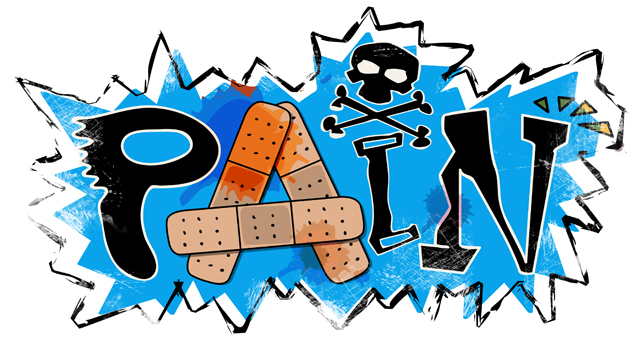
You’ve got a headache or period pain and you reach out for painkillers that you’ve always got stowed away somewhere at home, in your bag, or your car. You pop a couple of pills and a few minutes later (depending on how fast acting it is), you’re feeling better. That’s the end of it!
Well you know that’s not really the end of it here, we’re going to have to dissect all the processes that take place from the sensation of pain to the management of that sensation, yes, that’s what we do here! So sit back, put on your glasses (if you’re like me with messed up eye sight), and let’s do some pain learning!
What is Pain?
The International Association for the Study of Pain defines it is “an unpleasant sensory and emotional experience associated with actual or potential tissue damage, or as described in terms of such damage.” It is basically a sensation that hurts. It’s an uncomfortable feeling that could be steady or throbbing. It could be stabbing, aching or pinching. It’s not just a physical sensation, it could be emotional as well. Ever heard someone going through a heartbreak say they can literally feel the pain of their heart breaking? That’s legit!
How Do You Feel Pain?
You accidentally touch a hot surface and this causes tissue damage which is registered by pain receptors – connected to the skin on one end, and connected to the spinal cord on the other end. Here’s the process:
- Pain receptors imbedded in the epidermis (surface layer of the skin) are activated by tissue damage
- A signal travels up the nerve to the spinal cord
- In the spinal cord, neurotransmitters are released which activate other nerves that relay the signals to a part of the brain called the thalamus.
- The thalamus is a sorting station that relays signals to other parts of the brain. It relays the signal to the somatosensory cortex (physical sensation), frontal cortex (thinking), and the limbic system (emotion)
At the end of all this information transduction, you feel the sensation of pain in your finger (somatosensory cortex), think ‘ouch! what was that?’ (frontal cortex), and then you feel annoyed or irritated (limbic system).
Think about it for a second though … you actually moved your finger before you were even aware of the pain. Once the information reached the spinal cord, it also activated a reflex: motor neurons were activated and the muscle of your arm contracted, moving your hand away from the hot surface. THIS happened even before the information was relayed to your brain, so you pulled your arm away before becoming aware of the pain. That’s a protective kind of pain, it prevented you from further roasting your finger.
Types of Pain
Nociceptive pain
This is caused by injury to body tissues (a cut, burn or bone fracture). Postoperative and cancer pain also fit into this category. Pain sensation could be sharp, aching or throbbing, it could be constant or intermittent, and is usually worsened by movement or coughing. Think of coughing uncontrollably after having a c-section, now THAT’s painful!
Acute pain
A protective short-lasting pain that alerts the body to tissue damage. It’s a symptom of injury or disease and usually resolves as the injury or diseases heals. That’s the classic example of burning your finger on a hot surface. It hurts to alert you so that you moved your finger. Once the healing process of the little part of your finger you managed to burn heals, the pain the gone.
Neuropathic pain
This is caused by abnormalities in signal transduction of pain, whether in the nerves, spinal cord or brain. Pain sensation could be tingling, burning, shooting or electrical. People with this kind of pain could feel pain from stimuli that aren’t normally painful such as decrease in temperature or a light touch, and they could be more sensitive to painful stimuli. Imagine having to take an injection with this kind of pain … Yowzer!
Chronic & Idiopathic pain
A.K.A Persistent pain, can be caused by ongoing tissue damage, e.g. arthritis. In some cases, the pain can persist even after an injury has healed. Rather than being a symptom, it becomes a disease itself. The pain can persist for months or years after the initial injury. It becomes idiopathic pain when the cause is of unknown origin – there’s no detectable tissue of nerve damage. This is the most difficult kind of pain to treat.
“Neuropathic and idiopathic pain are like false alarms. The alarm goes off all the time, but there’s no fire and nothing to heal. The alarm system is broken.”
Psychogenic pain
This type of pain is caused or worsened by psychological factors. There could be a physical cause, but the degree to which is pain is perceived is not proportional to the injury. Sometimes a physical cause isn’t even found. Physiological pain is real! Think of that poor breaking heart.
In conclusion, pain is a feeling triggered in the brain. It could be sharp or dull, intermittent or persistent. It could be felt in one area of the body or all over the body. It could be a symptoms where it’s helpful in diagnosing a problem, or it could become a disease process itself. Pain is phenomenon that should be taken seriously! Without it, one can hurt themselves without knowing it or might not realize there’s a underlying medical problem that needs treatment. Don’t ignore pain, whatever the cause may be! If there’s pain that can’t be explained, or treatment isn’t giving the expected relief, it’s time to talk to a doctor that’ll give results.
*In a subsequent post, we’ll dissect the treatment and management of pain, stay tuned!
References:
Scientific Issues of Pain and Distress
Awesome post!
LikeLike
Thank you!
LikeLike